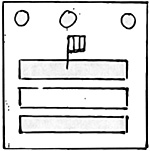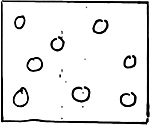Introduction
Before I attempt to describe 6mm wargaming and how I go about it, I feel I should give a brief description of how I arrived at this scale. Like most wargamers, I was always interested in history and started wargaming in 25mm thirty years ago. At this time, 25mm was the scale to game in, and I collected furiously and enthusiastically, so that after about five years I had a large Napoleonic French army (my main interest) and two smaller armies of ancient Persians and Renaissance Poles. Even at that time it was a struggle to attain such large numbers of figures, as I had only recently started to work and had got married.
I must confess, as with most compromises I was unhappy with 15mm scale figures and dissatisfied with my armies. Luckily my long-suffering regular opponent took the quantum leap of selling his 5mm and 15mm figures and turning up one night out of the blue with several units of 6mm figures. After getting over the initial shock I started to think about what I wanted from my wargaming. I mean I had all these wonderfully painted 25mm and 15mm figures and the effort to obtain them had been hard to say the least. Granted I could only fight representations of actual battles, i.e. my re-fight of Austerlitz was on a scale of one battalion representing one brigade but they did look nice.
Needless to say less driven (mad) gainers would at this time have given up gaming due to cost alone. In an effort to gain even bigger armies, I took the step of scaling down to 15mm figures, once more going through the cycle of amassing larger armies in my favorite periods. Armies are perhaps a misnomer to describe the 40 odd battalions of figures that I painted.
However, I felt dissatisfied with pushing around single battalions. I wanted to use divisions of twenty battalions at a time in my attacks. I wanted to re-enact Murat's charge at Eylou, obviously impossible with the scales I used. So I too took the step of giving 6mm a try. I can honestly say it was the best thing I had ever done. Within months I sold all my larger scale figures and began to use the cash to re-build my collection.
To re-cap then, like most wargamers I enjoyed history and wanted to re-enact as accurately as possible the tactics and strategy of the times portrayer 1. However unless I possessed an extremely large playing surface would never be able to. do this, never mind the cost of buying and painting the figures for larger re-enactments.
Figure Manufacturers
Once I decided to change scales I decide to look around at what was on offer. At that time the figures were only manufactured by Heroic .& Ros who supplied only a limited range. Fortunately I had become friendly with Ian Kay of Irregular Miniatures who was toying with the idea of producing a range of 6mm figures. The main difference between Ian's figures and the Heroic & Ros range was that Ian produced strips of 6 figures for infantry on one base as opposed t6 Heroic & Ros single figures.
Irregular Miniatures quickly began to expand their ranges and I naturally concentrated on these figures, supplemented by the Heroic & Ros range, which had some particularly fine figures to fill in the gaps. One of the first things I noticed when changing scales was the speed in building up my new armies, and just how cheap it was to do so. With. the sale of my 25mm figures I immediately opted to replace them with a French Napoleonic army which had always been my chief interest.
The beauty of the 6mm scale really hit home as I began to build the army. Instead of choosing individual regiments that I had been interested in, I opted instead to build up the army using detailed orders of battles I wished to fight. Starting with the Battle of Austerlitz, I moved on to Aspern Essling, Wagram, Borodino, Waterloo, and now finally, Leipzig.
Imagine having every battalion, and squadron for that battle. I suppose it's a form of dementia really. I should stress that 1 didn't just collect the French side but collected the opponents to. I even have Lestocq's corps of Prussians for the battle of Eylau.
Organization
John Reidy, my long-suffering wargame opponent, kindly wrote a set of rules specifically for the Napoleonic Wars in 6mm. What I had wanted was a game that was fun, accurate and quick to play. No longer would the concern be what happened to an individual company. Now brigades and above would be our main concern.
 As a consequence my units are based on the following method. For continental infantry and in particular French organized battalions I place three strips of Irregular Miniature figures on a base, with three Heroic & Ros figures in front to represent the skirmish. Additionally I attach mounted command figures to represent the brigade commander. See figure to right.
As a consequence my units are based on the following method. For continental infantry and in particular French organized battalions I place three strips of Irregular Miniature figures on a base, with three Heroic & Ros figures in front to represent the skirmish. Additionally I attach mounted command figures to represent the brigade commander. See figure to right.
As a result an infantry battalion is a self-contained entity and costs the princely sum of about 60p or about 75 cents. The underside of the bases have all, the details of the unit concerned, covered by clear sticky backed plastic, as is used to, protect book covers. The reason for the plastic is to record the casualties of the unit with chinograph pencil, which can be wiped off with a finger. At the rear of the bases are painted the colour codes of the brigade, division and corps.
 For light infantry the bases are different in that I use single Heroic & Ros figures
as shown in the figure to the right. For the cavalry, the bases consist of two strips of
Irregular Miniature cavalry.
For light infantry the bases are different in that I use single Heroic & Ros figures
as shown in the figure to the right. For the cavalry, the bases consist of two strips of
Irregular Miniature cavalry.
For larger battalions, i.e., Austrian and larger cavalry regiments, I merely Double the size of the base and increase the number of figures.
Over the last few years I've amassed the armies of all the main protagonists of the Napoleonic Wars and an awful lot of the minor states as well. However, it just didn't stop there as I collected armies from my other main interest periods as well.
Conclusion
As has been stated before in a different context, size doesn't matter and this is definitely true. We are always bemoaning that younger people are not coming into the hobby and I honestly believe one of the reasons is cost, and another reason is space. Not everyone can be a Duke Siegfreid or the late great Peter Gilder. The reality is most gainers are limited as to how much they can spend on figures and fittings. Using 6mm scale armies, anything is achievable not only cheaply, but also quickly. However, if the scale is to be approached correctly the visual appeal is still there and in many cases improved. I can assure the reader that the games that I have joined in with have not only been fun but also a miniature visual delight.
Painting 6mm Armies and Making the Terrain
Back to MWAN #103 Table of Contents
Back to MWAN List of Issues
Back to MagWeb Magazine List
© Copyright 2000 Hal Thinglum
This article appears in MagWeb (Magazine Web) on the Internet World Wide Web.
Other military history articles and gaming articles are available at http://www.magweb.com